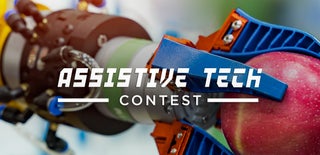Introduction: Assistive Tool Holder
As a special educator and maker, I am always looking for ways to help my students participate in classroom activities more effectively. Using Design Thinking, TinkerCAD, and 3D printing, I was able to create an adaptive device for a student for use in her art class. Below, I will show you my process and results.
Supplies
- TinkerCAD or similar design software
- 3D Printer and accessories
- Filament
- Pipe cleaners
- Tools for use with device
Step 1: Step 1: Empathize
The first step in Design Thinking is to empathize with the user.
My student (due to privacy concerns, no pictures or names can be used) was born with a physical disability affecting her arms. In particular, her arms are underdeveloped and does not display fine motor control including grip of small tools. Consequently, art class presented real difficulties for her in the use of tools for completing her art.
After observing her in class and speaking with her about her needs, I moved to the second step.
Step 2: Step 2: Define
After observing and speaking with the student, I determined that any device that would assist her would have the following characteristics:
- Easy to Grip- current tools being used in class required fine motor skills and many tools were not available in ergonomic forms.
- Easy to Change- Art class utilized a wide variety of tools such as pencils, pens, markers, pottery tools, paint brushes. The circumferences of the tool varied widely and multiple tools per class were used. Changing tools rapidly and easily was a high priority.
- Available and Inexpensive- Adaptive equipment is often expensive and the buying process is cumbersome when using school funds. It could take six months to a year of meetings and paperwork to confirm the need, identify the product, find an approved vendor, and finally order. My student needed it now.
With these constraints in mind, I moved to step 3
Step 3: Step 3: Ideate
In the third step I began my research. First, I looked for commercially available solutions and I found Stirex Ergonomic File And Paintbrush Handles. This was a great solution to the problems my student faced in art class. However, it did not meet the needs I established in Step 2. It did seem easy to grip a wide variety of tools, but the clamps utilized were not easy to change tools rapidly. The vendor is also in Australia, and the cost was high so the commercial solution would not be ideal in our circumstances.
However, this did give me inspiration. The text surrounding the handle used mentioned that it was a "pistol grip". This inspired me to look at firearm related grips. My thinking was that companies that produced firearms spent a lot of time thinking about ergonomics when designing their grips so I could use their solutions for my student. This insight led me to my next step which is to prototype.
Step 4: Step 4: Prototype
Looking on Thingiverse I found a handle designed from an AR-15 grip but made into a Kinect Handle credit to Arthur Schmitt. Using his design and modifying it Tinkercad, I created what you see above. I created a hollow space for various tools and hooks for rubber bands to hold the tool. I was finally ready to print.
Step 5: Step 5: Test
The fifth step is to test out the design. Initially, I had thought to use rubber bands to hold the tool. This turned out to be too complicated to change and tools moved around too much. I instead used pipe cleaners to secure the tool. This turned out to be easier to change and held a wider variety of tools with more stability. I tested it with the student and it would found to be sufficient for her needs in art class.
At this point in the Design Thinking process I would take more feedback and refine the design further. In this case, the design worked well enough for art. It was not the greatest design for handwriting so we embarked on another project: a custom pencil grip which I may write another Instructable about if there is demand.
Thanks for reading. I hope that by showing you my design process you have been inspired to use Design Thinking and 3D fabrication to assist those who may need adaptive devices.

Runner Up in the
Assistive Tech Contest









